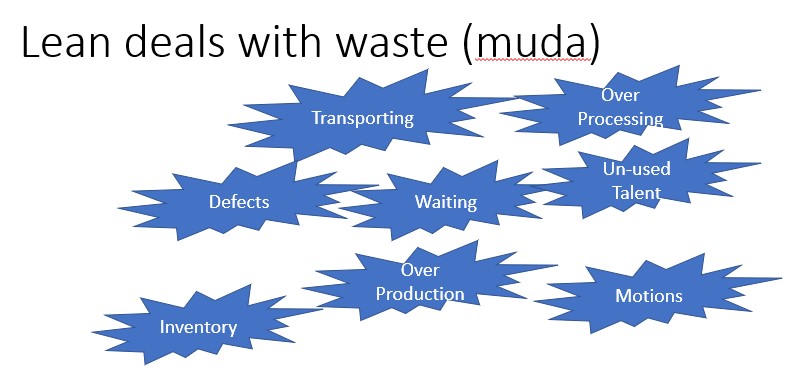In 2014, at an IMEC conference organized by the University of Toronto, Art Rice of Maintenance Technology Magazine said that in many cases “Lean is a form of Anorexia”. He was right then, and he is still right today. Perhaps, after Covid-19, it’s even more onerous a statement.
When I heard him, I realized that in many cases where I’ve seen attempts at “lean manufacturing” lean really means “understaffed”. In those cases, some of the lean manufacturing tools have been implemented, often with the help of outside expert help but lean results haven’t occurred. The introduction of “lean” in those companies was yet another attempt to cut costs without any deep thought as to what caused the high costs before introducing “lean”.
The diagram above shows the 8 types of waste (Muda) that lean tackles. People are not on the list! Yes, lean can save on costs, but cost-cutting without addressing the underlying causes of waste won’t work. Cost-cutting does not change the way that things are done and on its own, it cannot be successful. If cost-cutting has targeted staff reductions, then the remaining staff will attempt to make up for their lost colleagues’ work, only to find themselves overloaded. After all, nothing was done to change how they work. That feeling of being overloaded comes atop the fear that “I might be next”. Eventually, the laid-off staff is replaced with more expensive overtime or contractors. The real causes of unacceptably high costs are seldom dealt with.
The “Achilles heel” of lean manufacturing is the unreliable operation of the plant and equipment. Without high reliability from the assets themselves the objectives of lean – removal of waste, cannot be achieved. If equipment is unreliable, inventories of work-in-process and/or finished goods must be maintained to accommodate the frequent and sometimes lengthy downtime incidents. Optimizing your maintenance department to “fight fires” faster might reduce repair times, but it isn’t cost-effective. However, without any attempt to work smarter, it becomes the default approach that companies often make.
Rather than get to the root of the reliability problems, deal with them proactively and improve plant performance, organizations often choose (through inaction and sub-consciously) to deal with them reactively. When failures happen they get fixed. The machine has dictated the timing and the work scope needed. Maintainers run from breakdown to breakdown, often without even having time to perform Root Cause Failure Analysis to eliminate the problem in the future. You never quite catch up with all the failures and never quite move to a steady-state smooth operation. In fact, when in breakdown mode, time is rarely made available to do proactive maintenance.
Even if your organization does RCFA, it’s not enough. Ask yourself this question: “would you fly in a newly designed aircraft if you knew its maintenance program was being designed using RCFA?” I think I know your answer.
Most of us fly at some time, and we do it safely. Airlines use proactive approaches to managing failures so that safety and performance are enhanced. They rarely wait until something goes wrong and then respond. They have forecast what could go wrong, before it does, and take steps to manage the failure itself, or if that’s not possible, to minimize the consequences of it when it does happen.
Reliability and reliable performance are achievable. High levels of availability result from high reliability, but more importantly, sustainable long and incident-free operations depend on it. Lean operations must be reliable operations or they will not remain lean. Reliability also leads to improved performance in the areas of safety and environmental compliance. Finally, something your finance people will love to hear – it’s actually less expensive to run reliably than it is to run a reactive approach.
Is your “lean” organization too lean? Try our free maintenance and reliability maturity assessment.


